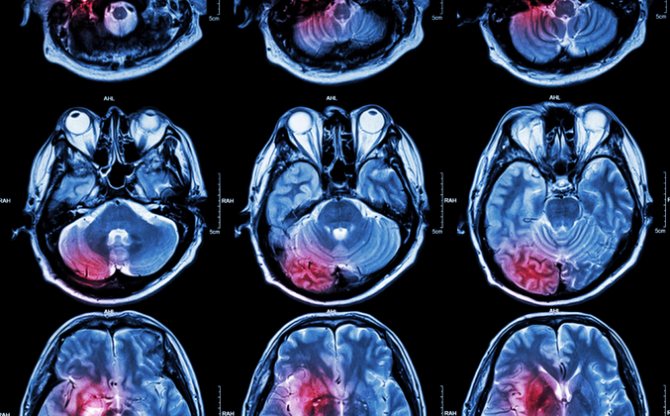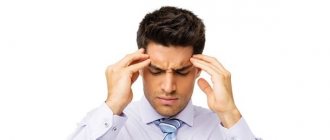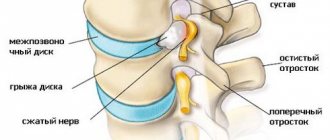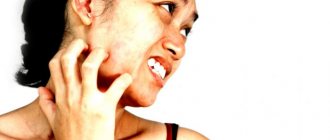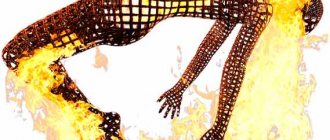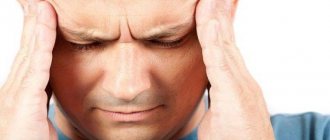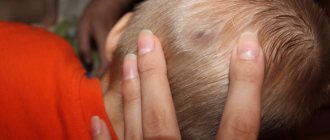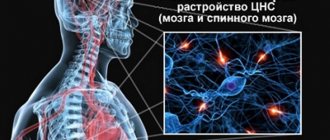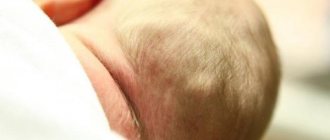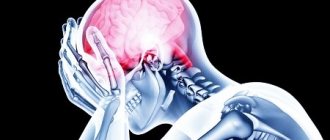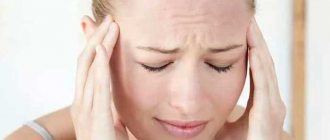Elena Anatolyevna Bardukova, neurologist, homeopath, 23 years of work experience ✔ Article verified by a doctor
According to statistics, every 5 patients can experience a burning sensation in the back of the head at an appointment with a neurologist. These symptoms may include pain, high blood pressure, a feeling that the heart is about to “jump out”, a feeling of anxiety, frequent dizziness, redness of the eyes, patients complain that the back of the head is burning and baking. Why does the back of my head burn? The answer is in this article.
The pain can be so intense that the neck and back of the head literally “burn” with fire. This kind of burning pain is dangerous. A person cannot endure such pain and almost always suppresses it with painkillers. It is not recommended to carry out self-treatment until the exact cause of the heat in the head is determined.
Pain in the back of the head and neck brings a lot of suffering to a person
There are quite a few reasons that cause a burning sensation in the neck and back of the head. These include inflammation, hormonal imbalances, and insufficient blood flow to the brain. The main diseases in which the back of the head and upper back burn:
- cervical osteochondrosis;
- muscle spasms;
- arterial hypertension;
- VSD – vegetative-vascular dystonia;
- migraine, cephalalgia (headache);
- high body temperature due to inflammatory processes.
Often, a burning sensation can occur not only in the head, but also in the shoulders, neck, and chest. Each of these signs is associated with a specific disease. In the article we will pay special attention to the symptoms and treatment of burning pain in the back of the head.
In this article we will tell you in detail about the causes of a burning sensation in the back of the head, treatment with medications, and help at home.
How to treat a feeling of heat in the head?
There is no standard treatment for diseases that give rise to the feeling that the back of the head is burning. If a burning sensation on the face occurs due to cervical osteochondrosis, treatment is aimed primarily at neutralizing the pathology. If the cause is frequent stress and overwork, treatment with antidepressants and sedatives is prescribed. For muscle spasms, massage and antispasmodics (for example, Spazmalgon) are indicated.
Several methods are used to get rid of burning sensation in the head area:
- manual therapy (special massage procedures);
- acupuncture;
- therapeutic exercises and a set of special exercises.
The main goal of therapy is to relieve tension from the muscles of the neck and shoulders. Doctors also prescribe courses of medications several times a year. The duration of one course is at least a month.
Treatment with tablets
If the top of your head burns afterwards, your forehead burns, or your skin tingles, you can take some painkillers as an emergency measure. After relief, it is recommended to consult a doctor. The following medications are usually taken:
| Name of tablets | How to use |
| Tampalgin | Contains analgin and tempidone. Effective for headaches and toothaches. Take 1 tablet up to three times a day. |
| Citramon | A product based on caffeine, citric acid, cocoa powder. The combined composition allows you to achieve maximum effect. Take 2 tablets three times a day. |
| Pentalgin | It contains a lot of components (analgin, caffeine, amidopyrine, etc.) In addition to the analgesic effect, it calms and normalizes sleep. |
Traditional methods
Traditional medicine suggests treating a symptom such as a burning headache with warming. This is justified only if the head is hot due to cervical osteochondrosis.
- Wrap yourself in a woolen scarf or make a hot compress with horseradish leaves and boiled potatoes. Remember that it is not the head that needs to be warmed up, but the cervical spine.
- Burning skin can be easily cured with pepper plaster or mustard plaster. As they say, we knock out wedges with wedges.
- For brave patients, there are recipes for rubbing radish tincture or honey in alcohol to help relieve the burning sensation.
- Fresh juices of celery, carrots, and pomegranate will help strengthen the walls of blood vessels and improve blood supply.
- A good recipe is to consume garlic and lemon in a blender on an empty stomach.
Exercises to relieve pain and burning in the back of the head
To get rid of a burning sensation in the back of the head, you can use an accessible, and most importantly free, method - a set of therapeutic exercises and self-massage.
What exercises should you do to stop headaches and burning in the back of your head?
- Sit with your back straight and your gaze straight ahead. Tilt your head left and right, trying to reach your ear with your shoulder. Repeat 15 times.
- While sitting on a chair, tilt your head down for 30 seconds. Straighten up, wait half a minute and repeat again. Number of repetitions – 15 times.
- Using your middle fingers, find a point below the back of your head at the beginning of your neck. Place your fingertips on it, make 15 movements clockwise, and then press on it for 1-1.5 minutes. Rest for a couple of minutes. Repeat the exercise 5 times.
- The exercise is performed sitting with a straight back. Gently turn your head to the left and slowly move your head towards your right shoulder, your chin should outline a semicircle, pressing against your chest. Bringing your head to your right shoulder, roll it back, trying to reach your back with your occipital region. Slowly return to the starting position. It is advisable to learn how to make a full circle. Repeat 10-15 times.
- Performed in the same position. Raise your shoulders up as much as possible, try to reach your earlobes. Freeze in this position for a few seconds and lower your shoulders back. Repeat 15 times.
- Move your shoulders first forward and then back, trying to mentally draw circles with them. Repeat 10 times.
Perform all exercises without overstraining your muscles, with smooth movements.
Video: exercise for headaches in the back of the head
Causes
Thanks to modern medical technology, neurologists can trace discomfort to nerve cells in the brain. For this purpose, positron, digital tomography or MRI is used.
There are many causes of burning and tingling in the head. Hunger, harsh light, excessive noise, prolonged viewing of TV or working at a computer - due to these factors, not only a headache, but also other sensations appear, including a burning sensation (in the occipital region of the head, in the temples, in the frontal , parietal part, etc.).
Diseases accompanied by a burning sensation in the head:
- infections (CNS diseases, viral, bacterial infections);
- elevated temperature (infection, sunburn);
- hypertension;
- mental illness (depression, stress, chronic fatigue);
- intoxication (any poisoning - exposure to toxic substances on the body: microbial toxins, metals, food, drugs...);
- vaccination;
- allergy;
- cancer with metastases to the brain (burning from excess pressure or stimulation of sensory nerves);
- sinusitis;
- menstruation;
- diseases of the spine, muscle spasms;
- cerebral artery atherosclerosis;
- ear diseases;
- eye diseases;
- dental disease;
- nose diseases;
- meningitis;
- encephalitis;
- tumors of brain tissue;
- nervous irritation;
- gastrointestinal diseases;
- eating habits: excessive acidification, chemical ingredients in food.
Overwork and stress
Excessive mental stress, fatigue, overwork usually cause increased body tension, overload of the muscles of the neck and face. As a result, the nerves are depressed and irritated, causing a burning sensation, most often in the back of the head.
A common cause of a burning sensation at the top or back of the head is fatigue. Most people cannot imagine a working day without a computer. This type of work involves significant eye strain, especially for people over 40 years of age. With prolonged sedentary work, these problems cannot be avoided. As a result of increased overvoltage, a burning sensation occurs in the back of the head, frontal and eye areas.
Special manifestations of discomfort
Many patients complain of a burning sensation throughout the head.
Less commonly, the burning sensation manifests itself in the form of itching inside the head, which can be compared to the feeling of sitting for a long time under the scorching sun. This itchy pain may be accompanied by monotonous, slightly throbbing pain inside the head, rapid pulse, high blood pressure and other symptoms.
If it is the scalp that is bothering the burning sensation – this is due to exposure to allergens, then you need to refuse to eat food to which you are allergic or try to avoid sources that cause an allergic reaction. Severe heat in the head can also manifest itself in the form of attacks.
But pain in the head, similar to tingling with needles, may indicate not only overwork of the body, but also the presence of serious illnesses.
Diseases that can cause headaches:
- A common cause of burning, tingling and sensation of heat in the head and neck is cervical osteochondrosis. With this disease, the intervertebral discs in the spine of the neck are deformed, which leads to their degeneration. The normal blood supply to the head is also disrupted, and tinnitus may occur. The disease progresses quickly in those people who work at a computer or drive a lot. In addition to burning, the development of cervical osteochondrosis may be accompanied by: numbness of parts of the face, crunching when turning the neck, burning and tingling in the back of the head and neck. The pain intensifies after being in the same position for a long time, even after sleeping in an uncomfortable position. The development of the disease is facilitated by: excess weight, sedentary work, lack of sports in life, and even high pillows.
- Panic attacks (sympatho-adrenal crisis) also provoke a similar symptom - about 2.5% of people on Earth suffer from them. Such attacks last from six to eight hours, in addition to a burning sensation in the head, patients also experience increased blood pressure, a fear of death, a person suffocates and shudders. The causes of such panic attacks can be tumors of the spine, adrenal glands or spinal cord, or severe stress experienced.
- Chronic fatigue. Constant depletion of the body's internal reserves of resources leads to many negative consequences and diseases that can develop into chronic ones. The tone of blood vessels in the head is disrupted, and a delay in blood flow in the brain often manifests itself in the form of a burning sensation inside the head.
- Tingling and heat in the back of the head may also indicate hypertension (tension of the artery walls). People who live and work in stressful environments are especially susceptible to it. In addition to a burning sensation in the head, hypertension is accompanied by tingling in the temples and crown of the head, mild dizziness, and problems with the eyes.
- Another neuralgic aspect. Inflammation of nerve fibers is often accompanied by pain in the area of nerve innervation. Burning and heat in the back of the head appears with neuralgia of the occipital nerve, as well as the nerve endings emerging at the level of the cervical spine. In this case, the pain has a pronounced burning character and cannot be treated with analgesics. Usually, in addition to pain, other symptoms appear, such as sensory disturbances. When you touch the scalp, the pain only intensifies, and paresthesia often appears (a sensation of crawling, tingling). Treatment is carried out by a neurologist; often the course of treatment includes not only medications, but also physical procedures. Therapy is carried out over a long period of time, from several months to a full year.
- If your head burns, this may also indicate eye diseases. Tingling and burning appear with frequent eye fatigue and decreased vision.
A burning sensation in the head can be felt in different ways.
Most often in one of the following options:
- burning with tingling;
- burns paroxysmally;
- the head begins to itch, the scalp becomes tight;
- it burns as if from overheating in the sun.
Often, “burning heads” occur in older people, but the younger generation is not immune from this.
| Cause | Pathological process |
| Cervical osteochondrosis | Thinning of the intervertebral cartilaginous tissue occurs and, as a result, irreversible changes in the skeleton. The formation of salt deposits leads to compression of blood vessels and nerves in the cervical region. Blood flows poorly to the brain, and this can lead to hypoxia. Elimination of manifestations (burning of the shoulder blades, dizziness, headache and neck, back of the head, back of the head “burning”) requires treatment of the key pathology. The left side is more likely to bother you, i.e. there is discomfort on the left side of the head, but a burning sensation in many other parts of the head is also possible. |
| Increased fatigue | Continuous stress, combined with chronic illness, impairs the functioning of blood vessels, thereby complicating the proper outflow of blood from the brain. Therefore, a person feels a burning sensation and heaviness in his head. To make an accurate diagnosis and get rid of these symptoms, you need to consult a doctor - a reflexologist, a neurologist, who will prescribe an examination: MRI, CT, etc. |
| Unhealthy Lifestyle | Overexertion (physical or mental), tobacco addiction, and lack of mobility provoke deterioration in vascular function, which destabilizes blood flow. It accumulates in the head, causing pain and burning. A balanced rhythm of life will lead to the disappearance of symptoms within 2 weeks. |
| Allergic reactions | There is a burning sensation of the scalp, the reason for which is the consumption of allergenic products or the use of bad cosmetics. This dermatitis is expressed in redness of the scalp, itching, dandruff, and rash. |
| Eye diseases | Pain occurs due to systematic eye fatigue and decreased vision. The eyes “bake”, the sensations in the temples and frontal lobes are tingling, burning. |
| Hormonal imbalance | An error in choosing hormonal contraceptives, the onset of menopause, and malfunction of the thyroid gland are factors of paroxysmal activity. Diagnosis requires an EEG and blood tests for hormone levels. |
| Neuralgia | Inflammation of the nerve fibers has clear signs: sensitivity is impaired, the back of the head and the crown “burn.” Therapy can last up to a year. |
| VSD, or vegetative-vascular dystonia | Vascular and central nervous system dysfunction causes disorientation, pain, and a burning sensation in the head. |
| Arterial hypertension | An increase in blood pressure is indicated by heaviness, pain in the back of the head, pulsation, heat in the occipital area, and tinnitus. Such symptoms progress with sudden movements. The cause of discomfort is the expansion of peripheral vessels. Here it is important to urgently begin pharmacological treatment to avoid the formation of blood clots that lead to strokes. |
| Sympatho-adrenal crisis | Panic attacks, being one of the manifestations of VSD of the hypertensive type, occur in 2.5 million people. Attacks last 6-8 hours. In addition to the fact that the back of the head is “on fire,” there are surges in blood pressure, lack of air, chills, and fear of death. |
| Neoplasms | Tumor formations of the brain cause compression of its tissue, compression of blood vessels and continuous burning pain in the head, against which analgesics are powerless. The problem can be identified by a feeling of nausea, severe fatigue, reflex disorders, and decreased vision. X-rays and EEG will help diagnose the tumor. A visit to an ophthalmologist and an MRI of the brain would be a good idea. |
Why does my head burn unbearably and hurt in the frontal area? The patient may have migraine or eye pathology. Also, discomfort in the forehead may indicate pharyngitis or sinusitis.
The left or right half of the head “burns” from the inside due to increased blood pressure. In addition, the localization of a burning sensation on the left or right can warn of the course of severe viral infections (meningitis, encephalitis).
A burning sensation in the head is possible with cervical osteochondrosis due to pinched nerve endings. This is characterized by localization of discomfort in the occipital region.
How to diagnose the disease
A timely comprehensive examination by a neurologist is of great importance. This will allow you to avoid complications, identify the causes and begin treatment. When it starts to “burn in your head,” a number of diagnostic measures are indicated:
- blood test (general, biochemical) - will reveal a range of chronic somatic pathologies;
- ophthalmological examination - will help to detect changes in the fundus using special equipment, check the quality of vision, the state of refraction;
- echoencephalography is a method for identifying large tumors based on the Doppler effect;
- 24-hour blood pressure monitoring – 24-hour monitoring of blood pressure levels with average readings;
- Electroencephalography – captures and records in graph form electrical discharges occurring in the brain. Using this technique, you can exclude epilepsy, find out the state of the functioning of parts of the brain;
- Magnetic resonance imaging is a safe method due to the absence of x-ray radiation. Detects the smallest neoplasms and vascular pathologies.
Dizziness and pain syndrome
Before treating dizziness with cervical osteochondrosis, as well as pain syndrome, it is necessary to understand the causes of their occurrence. Very often, cervical osteochondrosis is accompanied by symptoms such as headache and dizziness. Nausea is often added to these symptoms.
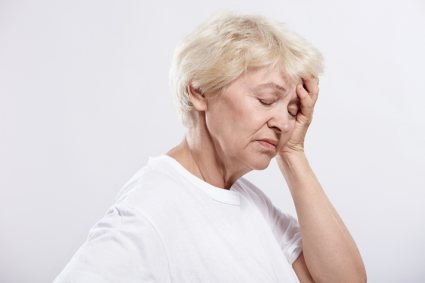
The reasons for feeling dizzy and experiencing severe pain are as follows:
In vertebral artery syndrome. This syndrome is characterized by throbbing pain in the head, the focus of which is located in the occipital part.
In compression of intervertebral nerve fibers. In this case, the neck hurts first, and only then the left or right side of the head.
Due to hypertensive syndrome. It is characterized by a bursting pain in the head. Sometimes it may feel like the pain is trying to escape from your head. But usually it does not last long and goes away within 2-4 hours.
Treatment
Usually, in order to eliminate dizziness with cervical osteochondrosis, the patient has to go through two stages of treatment. At the first stage, there is a direct elimination of pain in the head and neck area. For this purpose, painkillers and anti-inflammatory drugs are used. After the pain is eliminated, it will be possible to get rid of the very cause of the disease.
For this purpose, physical therapy can be used, in combination with massage and physiotherapy. The main thing to remember is that exercises can only be prescribed by your doctor. This is done taking into account the individual characteristics of the patient’s body.
Diagnostics and tests
Many types of burning and pain in the head have typical symptoms, so the correct diagnosis is made based on the medical history. The doctor may ask the patient a number of questions, such as:
- “How often does discomfort occur?”
- “Where are the unpleasant sensations located?”
- “How long does the burning and pain last?”
- “When did the first attack appear?”
In women, the dependence of troubles on the menstrual cycle is determined. In men, the condition of the prostate is determined (disorders of this organ may be associated with a burning sensation in the head).
Important! If there is a burning sensation on the surface of the scalp, you should reconsider the hair products you use - this could be an allergy.
Signs of other diseases are also determined, in particular:
- sinusitis (at the same time there is a burning sensation in the nose);
- dental diseases;
- medications taken.
A complete neurological examination is aimed at excluding aneurysm, meningitis, tumors, also accompanied by a burning sensation in the head.
Blood tests can reveal thyroid disorders, anemia, and infectious diseases.
Electroencephalography measures the electrical activity of the brain. Testing may reveal abnormal brain function.
Also, for burning in the head, CT or MRI is used.
How symptoms may appear
A burning sensation in the scalp can manifest itself in different ways:
- burning inside the head;
- attacks appear periodically;
- feeling as if overheated in the sun;
- tightening of the skin on the head;
- monotonous throbbing pain inside the head;
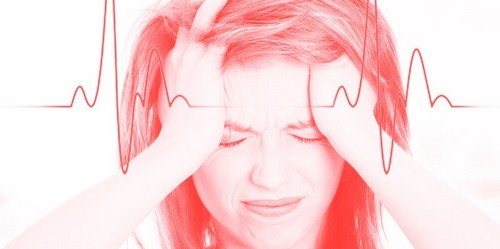
Throbbing pain in the head can indicate many diseases - heat in forehead;
- pulls the throat and neck;
- pain in temples;
- girdle pain - it seems to arise inside and covers the entire head;
- burning in the cervical region.
How a patient is examined
The specifics of symptoms can clarify a lot, but this is not enough to make a diagnosis. If a problem arises, you should go to a therapist, who will conduct an initial examination and refer you to a specialized specialist. Depending on the causes of the disease, the condition can be treated by a therapist, neurologist, ophthalmologist, ENT specialist, psychologist or psychotherapist, or orthopedist.
The list of diagnostic studies is selected individually. It is mandatory for the patient to donate blood and urine for general and biochemical tests. His blood pressure and temperature are measured and his fundus is examined. The most effective methods for diagnosing headaches are MRI, CT, EEG, ultrasound of the vessels of the brain and neck. If hypertension is suspected, blood pressure monitoring is indicated. In some cases, they resort to performing a lumbar puncture.
Diagnostic measures
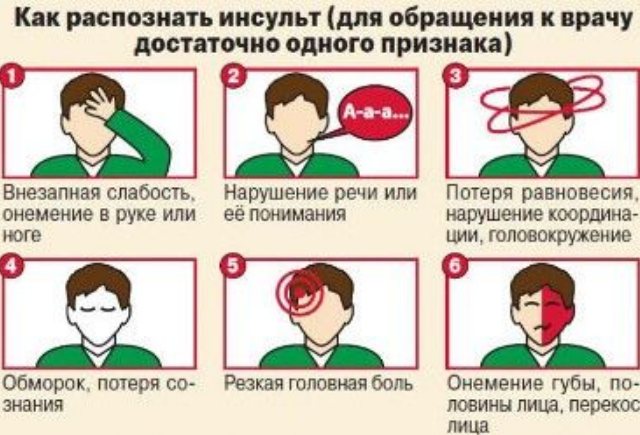
If you have symptoms of a stroke, you should urgently call an ambulance
If a burning sensation in the back of the head occurs regularly, regardless of the presence of other complaints, you should consult a doctor to clarify the diagnosis. For the following accompanying symptoms, it is recommended to call an ambulance:
- fainting state;
- disturbance of consciousness up to its loss (help is called by others);
- repeated vomiting;
- visual or speech impairment;
- high blood pressure numbers.
In case of moderate pain syndrome and absence of life-threatening conditions, a planned visit to a therapist is permissible. The diagnosis is made based on the following measures:
- clarification of complaints;
- general examination;
- consultation of narrow specialists: neurologist, ophthalmologist, cardiologist, psychotherapist;
- laboratory tests: general blood and urine analysis, glucose, biochemical analysis;
- ECG;
- visualization methods: X-ray examination, computed tomography and magnetic resonance imaging, angiography of the vessels of the head and neck, ultrasound examination of the arteries with assessment of blood flow in them.
This is a full range of activities, some of which are not mandatory if the diagnosis is confirmed at any stage.
Treatment options
If possible, treatment of discomfort begins with non-pharmacological methods. If it is necessary to use a medicine, the specific remedy is selected in accordance with the following characteristics of the symptom:
- type;
- the presence of other diseases;
- medications taken;
- intensity of unpleasant sensations.
Medicinal groups that can be used to treat a burning sensation in the head:
- Antidepressants. Some antidepressants can help relieve pain and burning that cannot be suppressed with other drugs. Antidepressants are also used to treat depression that causes chronic pain.
- Antiepileptic drugs. They are commonly used to treat epilepsy, but are also used for long-term nerve pain. Antiepileptic drugs are especially effective against burning pain.
- Local intravenous anesthetics. Recommended for benign musculoskeletal pain, administered by injection. Prescribed by a doctor.
- Anxiolytics. Used in people with chronic severe burning pain. The drugs are addictive!
- Neuroleptics. Relatively little used. Used for discomfort associated with anxiety, psychomotor impairment, insomnia and neuropathic pain.
Auxiliary measures also include methods aimed at alleviating unpleasant sensations (various relaxation exercises, meditation).
Other non-pharmacological treatments include acupuncture, physical therapy, etc., which may be used when other methods are ineffective. The decision on what to do in case of burning and pain in the head is made by the doctor. Self-medication, without determining the cause of the problem, is fraught with negative consequences.
Patient Questions
Question: I am 30 years old. I often have burning pains in my head, as if it were on fire. The pressure is sometimes low, severe dizziness and the back of the head burns and moves to the side. I work at the computer and rarely go for walks. What happened with me?
Answer : You have a neuropathic headache. More likely, the nerve root was simply pinched by the neck muscles. This can cause cervical osteochondrosis, which causes the following symptoms: tinnitus, decreased vision, fainting, balance problems, darkening of the eyes. You need to make an appointment with a neurologist and have the brachiocephalic arteries examined.
Pinched nerve root
Question : I am 49 years old, weight 56 kg. Recently I felt as if the back of my head and neck were burning. I have a sedentary job, these symptoms appear in the afternoon. I went to a therapist, they prescribed me Kombilipen injections, Artrosan injections, and then it came in tablets. I didn't notice any changes. Next I was referred to a neurologist. He prescribed Katadolon, Neuromultivit tablets. The burning sensation in my head has decreased slightly. I am currently taking Carbamazepine. A burning sensation rarely appears in the back of the head, but remains in the neck. I really don’t like that I’m undergoing treatment, but there’s almost no result. Do I need to undergo additional diagnostics, and is it possible to cure these dangerous symptoms?
Answer : Go through an additional examination - MRI of the cervical spine and brain. And only after this should treatment begin. Medicines should make up 25% of all treatments. It is necessary to add therapeutic exercises, physiotherapeutic procedures, and lifestyle changes. There is no point in waiting and hoping that only pills can help. The main thing is proper treatment and prevention.
Question: I am 25 years old. Recently I was driving a car and got seasick. When I got out of the car, I vomited, and a sharp pain appeared on the left side of the back of my head, inside my head. Aching pain appears periodically for the third day. When I touch the place at the back of my head, I feel pain. There was no temperature or pressure for 2 days, but there was nausea and vomiting. On the 3rd day, severe burning pain appeared in the parietal region, and the pressure jumped. I took pills for high blood pressure, felt better for 3 hours, then the symptoms returned again. There were no problems with blood pressure before. What happened to me?
Answer : Most likely, you had a hypertensive crisis, but there could also be some other neurological problem, which is why your blood pressure has risen. You need to make an appointment with a doctor as soon as possible; you cannot take medications without consultation. Before seeing a doctor, ensure yourself peace, reduce the stress on your body, drink more, for example, tea with lemon and honey.
Manual therapy
This type of treatment is based on manual therapy. Its development was influenced by oriental medicine, where this method first began to appear. Chinese experts knew a lot about medicine; with their hands they acted on certain points of the affected area on the human body and had a significant effect on organs and tissues. Thanks to manual therapy, the patient felt relief and was healed in the shortest possible time.
Manual therapy is important for the patient, as it can improve the condition of the musculoskeletal system, while the patient will no longer need to take a variety of pharmacological drugs of a pharmacological nature, which can adversely affect the organs of the gastrointestinal tract.
Self-massage for burning in the back of the head
- start the massage by kneading your ears with your palms;
- then place your palms on your ears and massage your head with your fingertips;
- then start massaging the occipital area without lifting your palms from your ears.
Yoga is very useful, the main thing is to conduct classes with a qualified specialist.

Yoga significantly improves the condition of the body
Don't forget about manual therapy. When sessions are carried out by a professional chiropractor, the pain can go away for six months or more. Treatment in this case is carried out only in courses.
Complex of medical procedures
After making a diagnosis, the doctor draws up a treatment plan. It takes into account not only the type of problem, but also the age, general condition, gender, and individual characteristics of the patient. It is very important not to try to cope with a headache on your own, even when its causes are known. Experiments will not get rid of the problem, but will only make the situation worse.
The treatment regimen depends on the type of problem:
- osteochondrosis of the cervical spine - physiotherapy, intake and external use of NSAIDs, massage, chondroprotectors, exercise therapy, nootropics to restore microcirculation;
- panic attacks - consultation with a psychologist, identification and treatment of diseases of internal organs that may be provocateurs;
- chronic fatigue - correction of the daily routine, proper sleep, taking sedatives, restorative drugs, vitamins;
- mental stress - the use of relaxation techniques, physiotherapy, massage, sedatives;
- arterial hypertension - antihypertensive drugs, symptomatic therapy, combating the provoking factor (metabolic problems, atherosclerosis, obesity);
- occipital neuralgia – eliminating the cause of pain, relieving pain;
- spondylosis – diet, exercise therapy, massage, drug treatment;
- hypothermia - rest, taking NSAIDs, warming up after the end of the acute period;
- intracranial hypertension - diuretics, lumbar puncture, eliminating the cause of increased cerebrospinal fluid pressure;
- VSD – complex therapy depending on the etiology of the disease and clinical picture;
- cervical migraine – combating the provoking factor, relieving the pain syndrome;
- Tension headache – normalization of the daily routine, reflexology, taking sedatives.
If a burning sensation in the back of the head is not a systematic symptom, occurs suddenly, and is not accompanied by other alarming signals, you can try to relieve the pain yourself. Sometimes it is enough to apply a cold compress to the sore spot, massage the collar area, or take a relaxing bath.
Why does the back of my head burn?
Often, a burning sensation in the occipital region manifests itself in the form of short-term attacks. Therefore, people are in no hurry to seek medical help. But such changes are usually symptoms of more complex diseases that respond well to treatment in the initial stage. Therefore, when the back of the head burns constantly or momentarily, it is necessary to urgently undergo a medical examination.
There are many factors that provoke a burning sensation in the back of the head. In medical practice, the main causes are divided into two groups:
The first group includes:
- Bad habits. Constant intoxication of the body from drinking alcohol-containing drinks and smoking leads to vasoconstriction. This provokes the development of tissue hypoxia, resulting in burning, tingling in the back of the head and headache.
- Physical inactivity. Prolonged sedentary work, traveling by car and insufficient physical activity slow down blood circulation. This reduces its entry into the brain and disrupts its cellular nutrition.
- A sharp change in hormone levels. This condition is more common in women. With natural physiological changes, such as the menstrual period, pregnancy, menopause, testosterone and progesterone levels change. This negatively affects the cardiovascular system.
- Physical and emotional exhaustion. Heavy loads and lack of proper rest provoke the development of autonomic disorders. As a result, vascular tone increases, which interferes with the normal outflow of blood.
The second group of provoking factors includes the following diseases:
- Osteochondrosis of the cervical spine. As this pathology progresses, dystrophic changes occur in the vertebrae and surrounding soft tissues. This disrupts the blood supply to the brain. As a result, a sharp burning pain appears in the back of the head.
- Cervical migraine. With this disease, a burning sensation in the back of the head is accompanied by pain radiating to the frontal and temporal zones. Appears periodically.
- Neoplasms in the brain. As tumors grow, they destroy myelin fibers. This process causes a burning sensation from inside the skull.
- Cervical spondylosis. A burning sensation occurs against the background of the development of osteophytes. This pathology more often manifests itself in old age.
- Arterial hypertension. In this case, the back of the head usually burns in the morning. The pain can radiate to other areas of the head. The disease has no gender or age. Therefore, the risk group includes all adults and elderly people.
- Panic attack. This psychosomatic disease not only causes a burning sensation in the back of the head, but is also accompanied by tachycardia and a severe attack of fear.
A burning sensation in the back of the head can be supplemented by multiple symptoms, which help determine the etiology of the burning pain. For accurate diagnosis and differentiation of diseases, additional examination is carried out.
Burning sensation due to hypertension: how to get rid of it
High blood pressure can be the result of frequent stress, overexertion, cholesterol in the blood vessels, bad habits, diabetes, kidney dysfunction, and taking certain medications. If blood passes through the vessels under high pressure, it begins to put pressure on the walls, which causes a burning sensation. Painful sensations occur in different areas of the head - on the top of the head, in the back of the head, in the temples. Hypertension is dangerous because it provokes a stroke.
High blood pressure can be treated in several ways:
As a rule, hypertension affects overweight people and those who smoke or abuse alcohol for a long time. To restore the physical functions of the body, it is necessary to fight obesity, eat right, drink enough fluids, quit bad habits and actively engage in sports (under the guidance of a trainer).
Various medications that can only be prescribed by a specialist help reduce high blood pressure. Since burning can occur for various reasons, first of all it is necessary to understand which medications will help the patient, but at the same time will not be contraindicated. Thiazides, sulfonamides, beta-blockers, ACE inhibitors, sartans, etc. are often recommended. You can also additionally take magnesium, vitamin B6, and fish oil.
If hypertension is caused by hormonal disorders, diabetes mellitus or kidney pathologies, then first of all it is necessary to eliminate the cause of high blood pressure. Treatment will be prescribed by a highly specialized specialist - endocrinologist, nephrologist, etc.
Noises and ringing in the ears
Very often, a patient with cervical osteochondrosis may be bothered by symptoms such as ringing and noise in the ears. Moreover, they can be so strong that they turn into real torture for a person. But it is worth saying that noise and ringing can also occur due to other diseases. Therefore, if such symptoms occur, you should first consult a specialist.
But if your doctor has diagnosed you with cervical osteochondrosis, then it is important to know the reasons why these symptoms appear.
Causes
The noise itself occurs due to the fact that the nerve cells of these devices do not receive the proper amount of signals from the brain. Because of this, the hearing aid itself may begin to produce signals in the same rhythm. As a result of all the processes described, noise occurs in the head.
Noise does not come alone. It can very often be accompanied by ringing, clouding or blurred vision, pain in the neck, head, sleep disturbances, and a feeling of dizziness. But after you manage to get rid of the headache, the noise, ringing and other symptoms disappear.
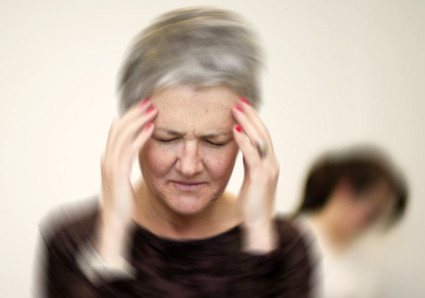
Vegetative-vascular dystonia is a modern disease
Autonomic dysfunction is a disorder in the regulation of organ function by the nervous system. Its symptoms are extremely rich and can be expressed individually in each person.
With vegetative dysfunction, the head hurts and there is pressure on the ears. Some may feel as if their head is being squeezed tightly, while others may feel a strong pulsation in the temporal region. When you get sick, your blood pressure often changes, so if you vomit, you shouldn’t be surprised.
2. Optical illusion - the viewing angle deceptively changes, flies appear;
3. Appetite is disrupted, apathy appears.
What to do? Do not rush to take pills or pay a lot of money for miracle herbs; the main method of treating autonomic dysfunction is psychotherapy sessions. A professional psychotherapist will conduct an analysis, help you find the source of nervous tension, and select an effective treatment method, for example, hypnotherapy.
Hyperthyroidism
Heat in the head also indicates endocrine problems. In particular, about hyperthyroidism - increased function of the thyroid gland. With this pathological condition, it produces slightly more thyroid hormones than the body needs. They, in turn, speed up metabolism.
In this condition, there is an increase in body temperature and a sensation of heat and burning in the head. Moreover, the patient is in an excited state, he has a rapid heartbeat, trembling limbs, and increased sweating.
